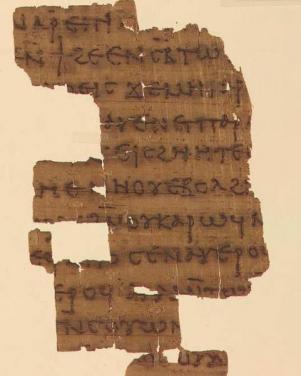
Yale Papyrus Fragment from the Nag Hammadi Gnostic Library Codex III, containing The Dialogue of the Savior
(Yale Beinecke Library)
Concluding passage of the Dialogue of the Savior (95-96), a Gnostic dialogue between Jesus and his disciples; Yale Beinecke Library papyrus collection p. CtYBR inv. 1784. A Coptic translation of a lost Greek original. This unique fragment joins and completes Nag Hammadi manuscript Codex III (p. 145) in the Coptic Museum in Cairo, Egypt. The manuscript was copied in the fourth century A.D., but the Dialogue must be much older, reflecting a very early stage of Christian literature and theology. The work’s relationship to the canonical gospels and their sources is a matter of keen interest. The ancient Nag Hammadi “library” was a hoard of thirteen heretical manuscripts, buried in a pot for safe keeping in the Egyptian desert perhaps around A.D. 400, when the orthodox Christian establishment was actively rooting out heretics and their writings. The Nag Hammadi hoard-often loosely called the “Gnostic gospels”-has opened up entirely new vistas on early Christian scripture and thought, presenting great challenges for scholars of ancient Christianity. Yale faculty members have played a major role in the reconstruction, publication, and interpretation of these manuscripts, authoring editions, translations, and commentaries of seventeen works from the Nag Hammadi collection.